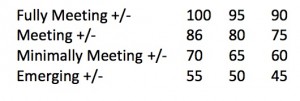The Disclaimer: First up and straight out I am still required to submit ‘percentages’ that translate into a letter ‘grade’. Secondly I do not grade on the ACTFL continum yet of labelling proficiency from novice low to intermediate and beyond. Thirdly I still look at the ‘four’ skills – reading/writing/speaking/listening but my summative assessments are oral interpersonal, presentation writing and interpretive reading.
The Problem: What does a 6/6 mean? Why do kids ask “How do I get an A?” and not “How fully am I meeting expectations?” and even more key – why are they asking me how they are doing? Don’t they know? Can’t they articulate where they are in meeting expectations for a unit? Why does my gradebook look like this?
And More Pressingly…. How do I meld the desire to address student goals and achievement with the requirement of keeping ‘grades’ in my province.
So…it started with removing all numbers from my rubrics. Big step. Removing the ‘calculation’ from the task.Now I find myself saying “In order to be fully meeting…” and students are catching on. In fact I have gone a step further and ask them to complete the rubric for the assignment/task in advance to set up/establish where they think they are in addressing expectations. Then after my evaluation they get ‘both’ back to see how their perceptions, and mine, line up.
But how to represent this in my gradebook and still come up with a grade? My solution is not mine but rather is taken from work done with an amazing colleague, Connie Santos, in my school’s English department. She developed a grid to translate the descriptors to ‘marks’. This is still a work in progress for me but the maximum that a student can achieve is “Fully Meeting +” and this is my 100%. The descriptors and % are here… 
Now my gradebook is a real combination that is beginning to reflect my shift from ‘numbers’ to descriptors. I have created a series of ‘special scores’ that work as a percentage of the ‘score’ of the task. So the O-FM code is a special score of 95 – meaning that it translates to 95% of whatever the assignment is out of
Now what students are seeing is:
 Some details as to what you are seeing:
Some details as to what you are seeing:
Numbers – quizzes on items that students have had at least 1 formative assessment with feedback in. Any achievement here is ‘re-doable’ upon student request to show further mastery – at their request.
C/Incl/NHI – pop-check in corrections, written work feedback and ‘homework’ (such as it is) completion
MM-….FM+ – Writing – a major piece or summative assessment in writing.
O-NYM ….O-FM – Oral evaluation – either by me or by them for class speaking/interpersonal activities and tasks
P-NYM….P-ME – Project/Out of Class Work – This is generally a ‘meeting/minimally meeting/not yet meeting’ mark for ‘project work
This experiment is definitely a work in progress. And I understand that I run the risk of ‘confusing’ readers (almost as much as I am as I try to refine and use this). But I am really pleased with where this is heading…and hoping, just hoping, that one day I will be allowed to enter descriptors on report cards…and not a percentage!
Colleen



3 Comments
Leave a reply →